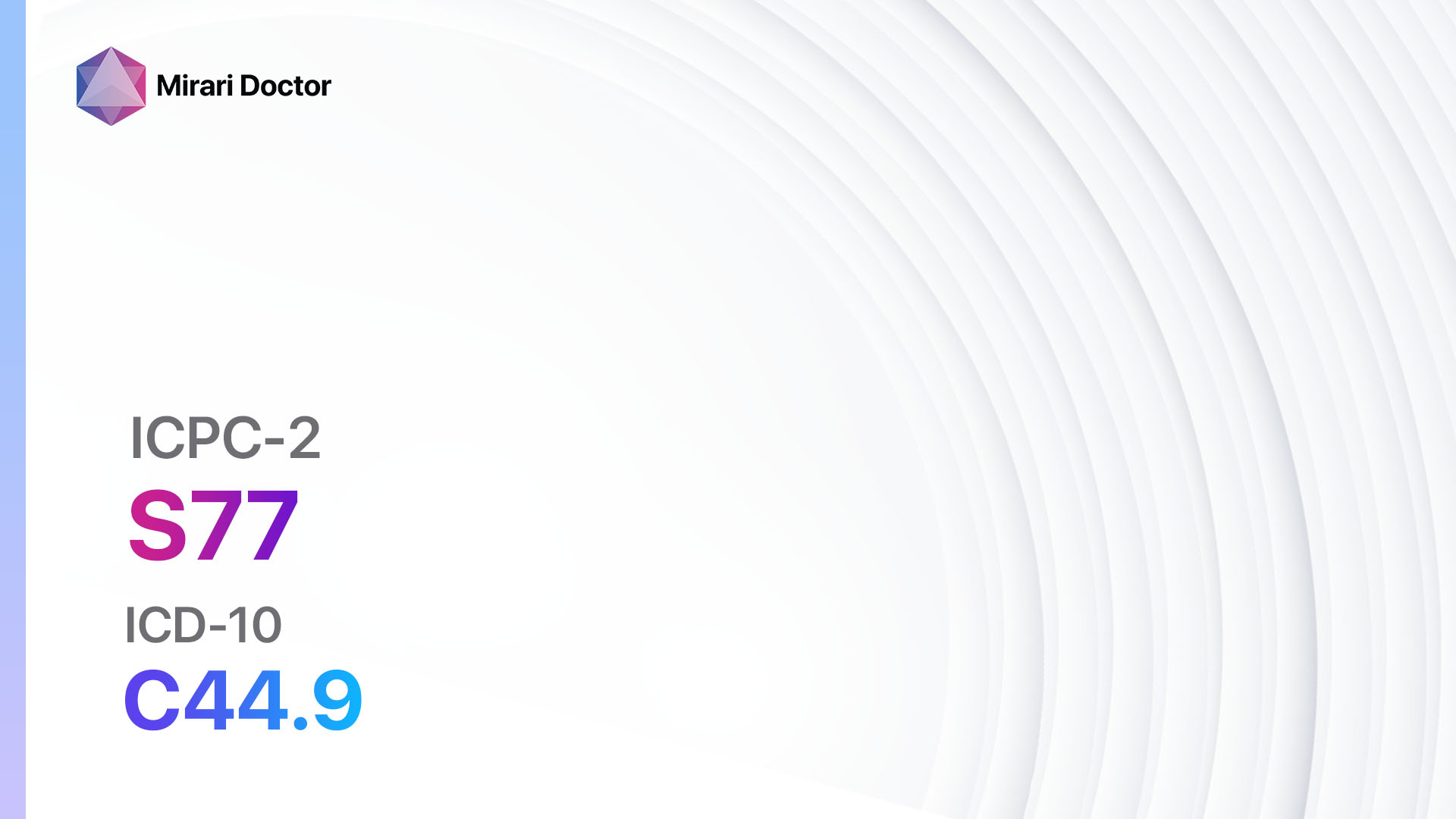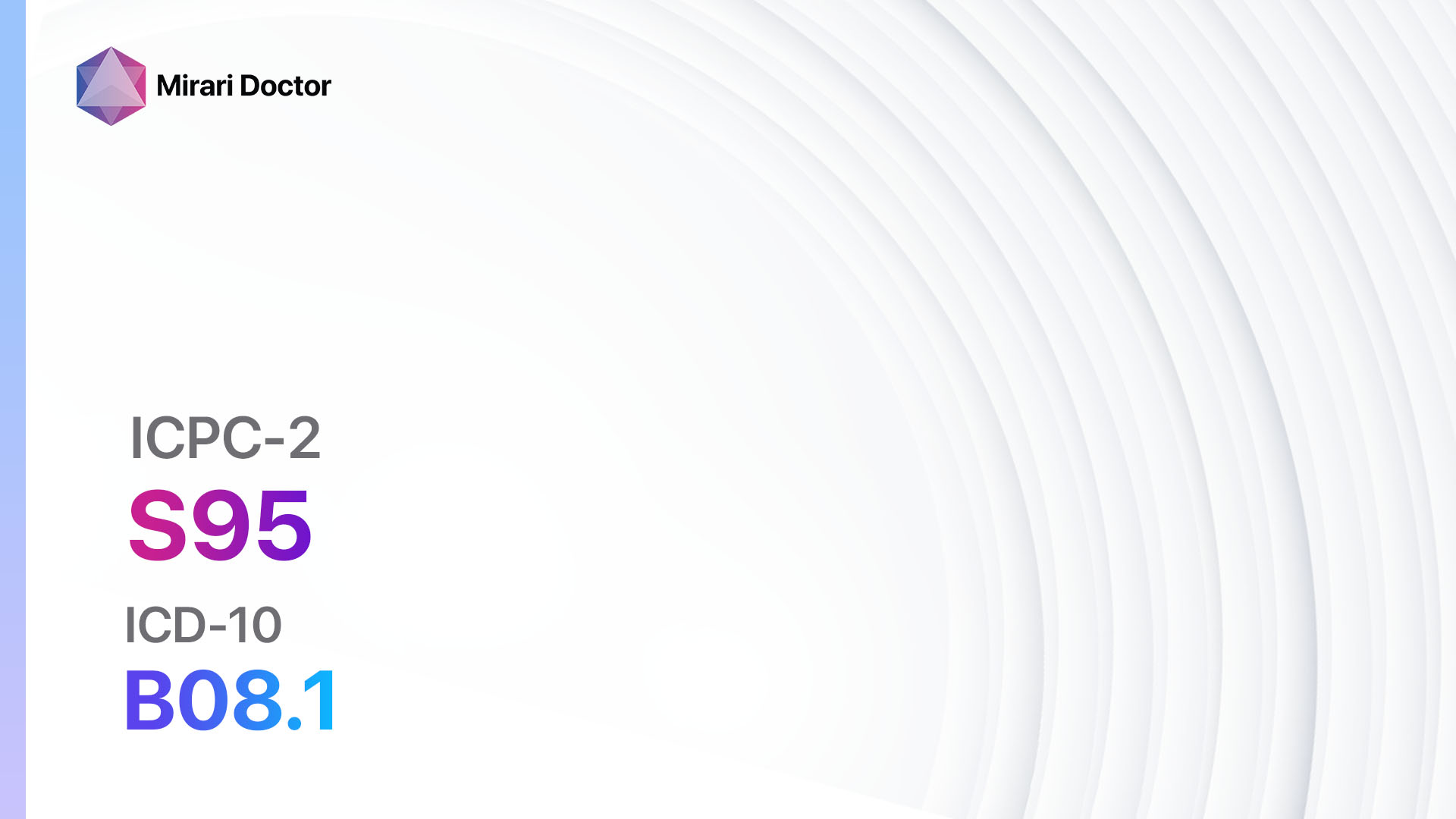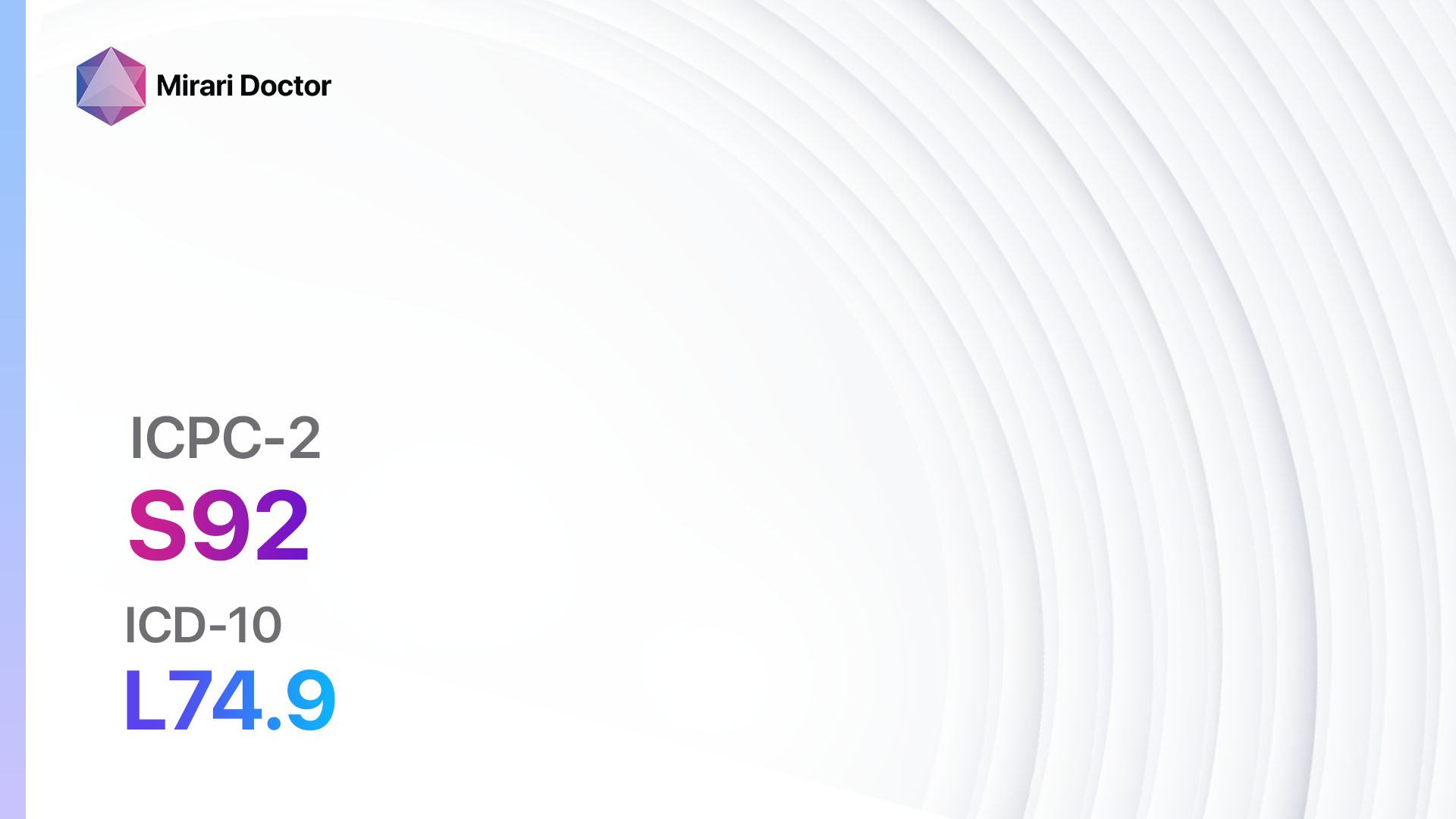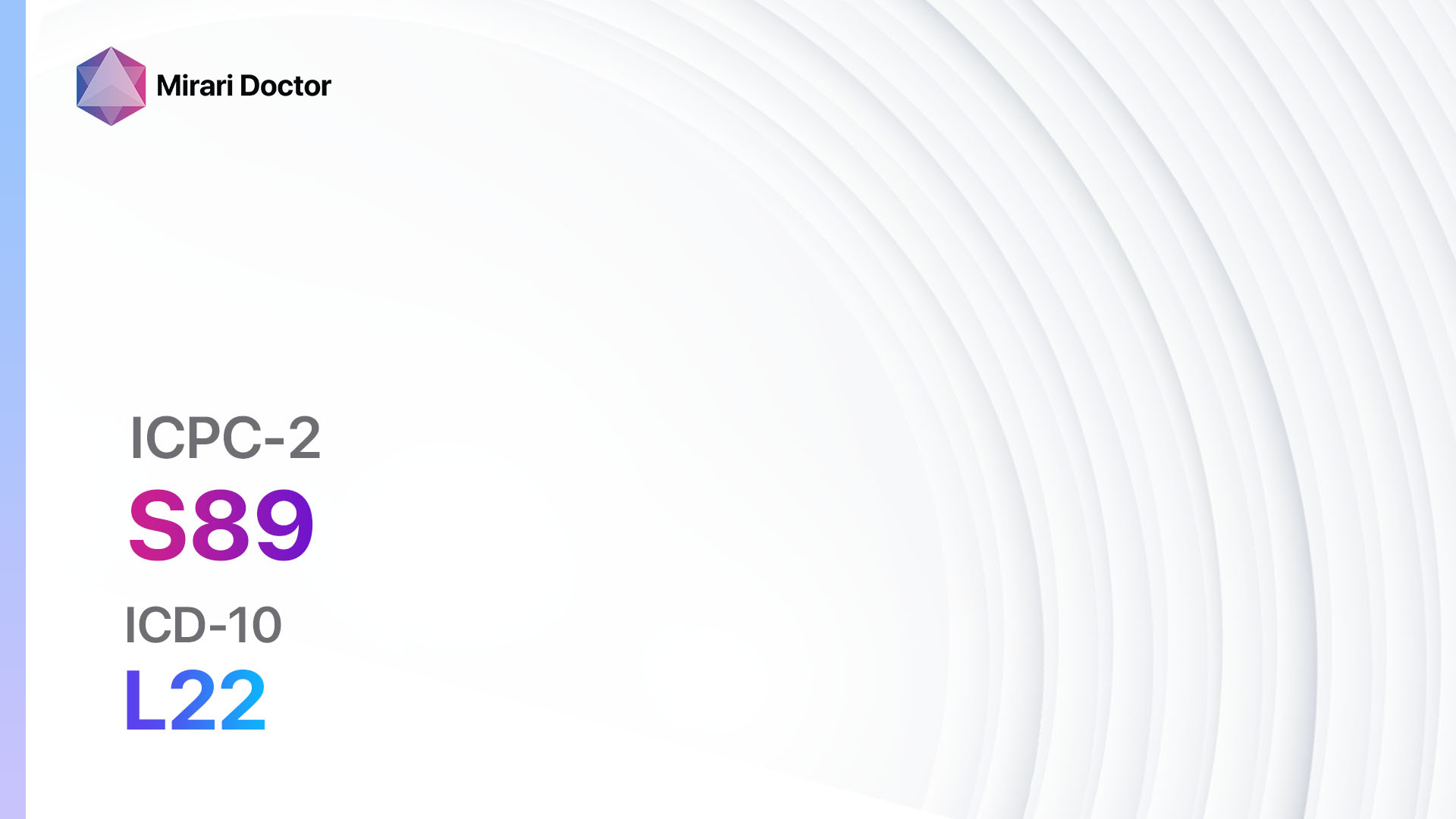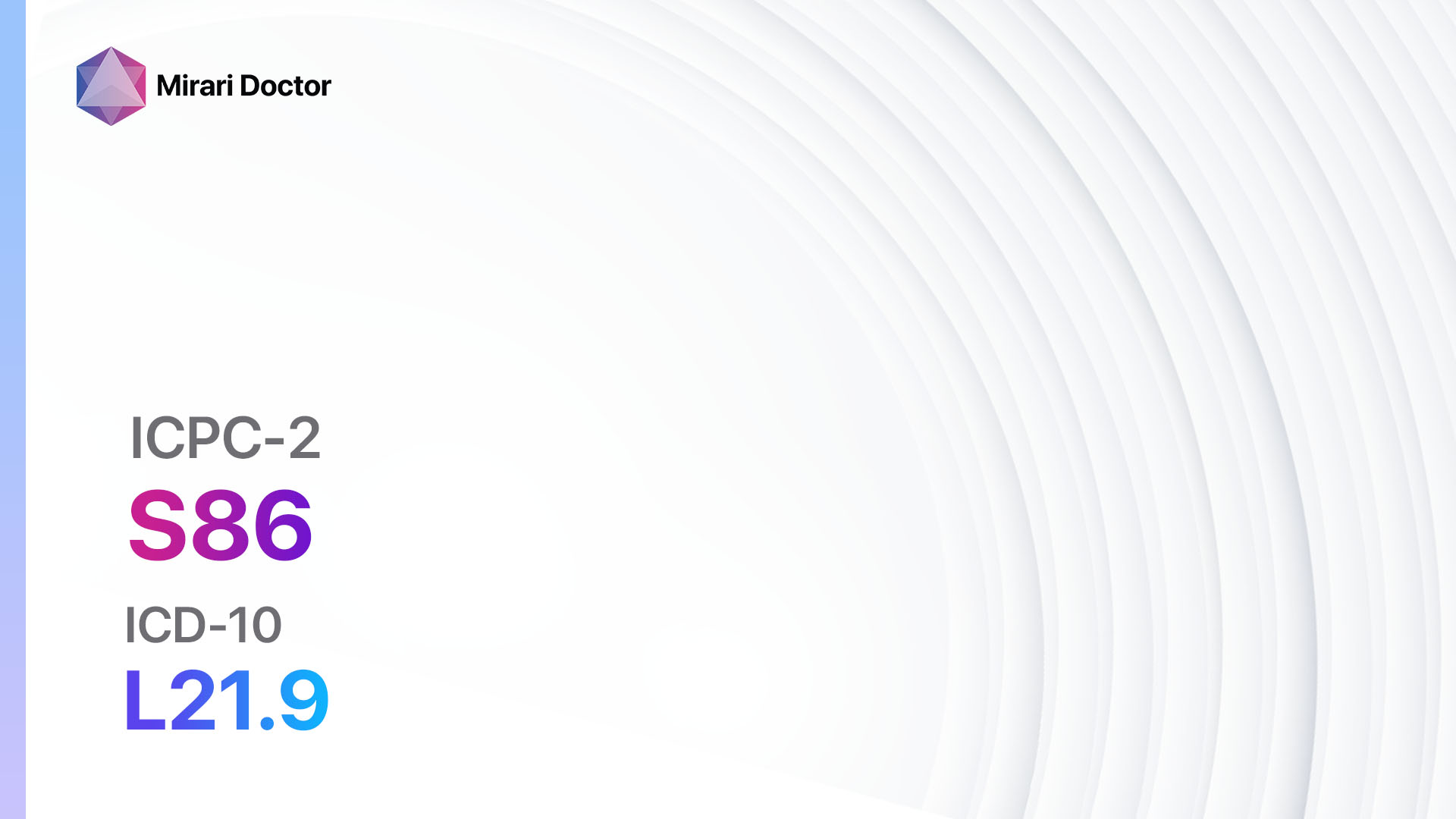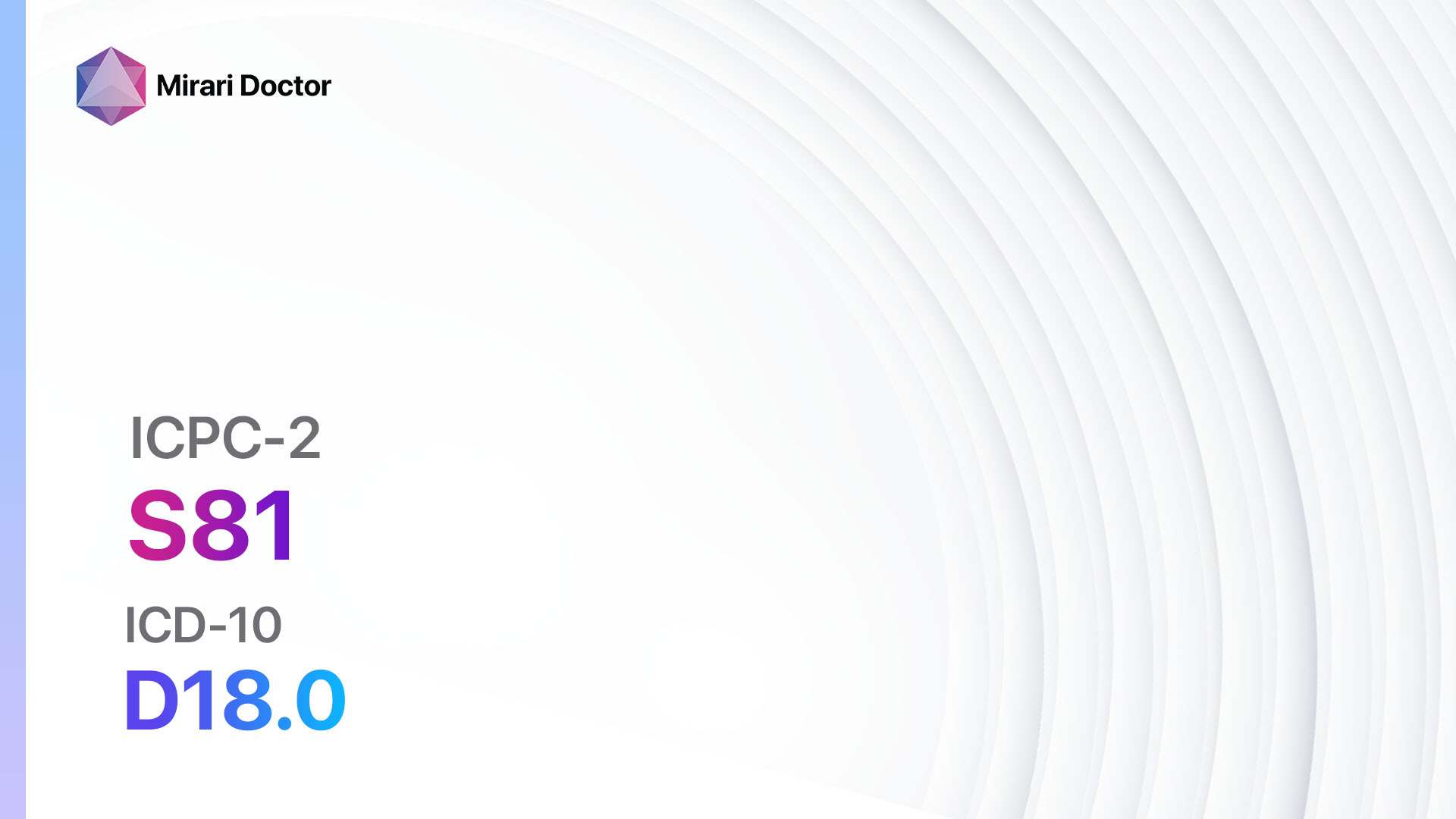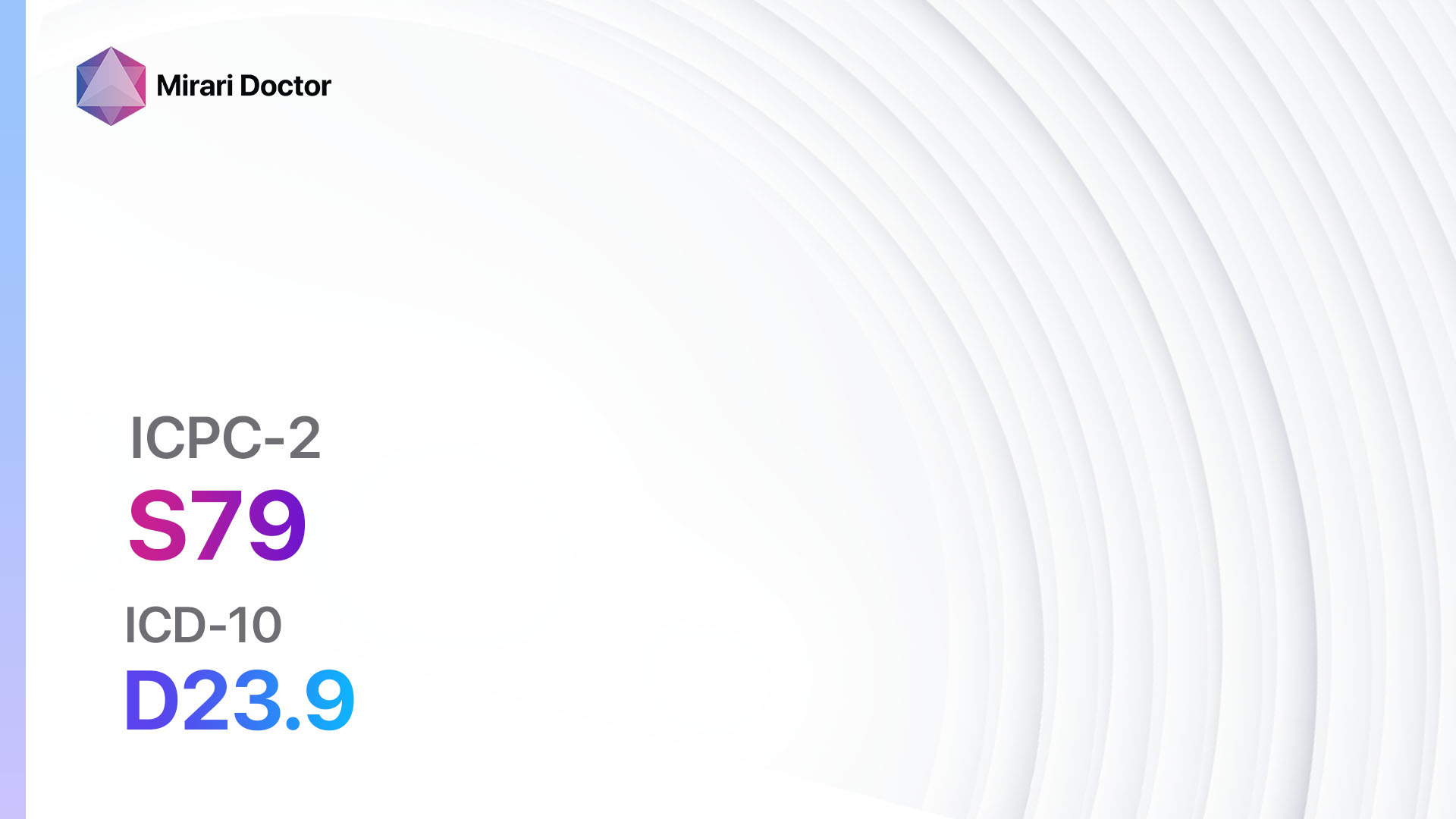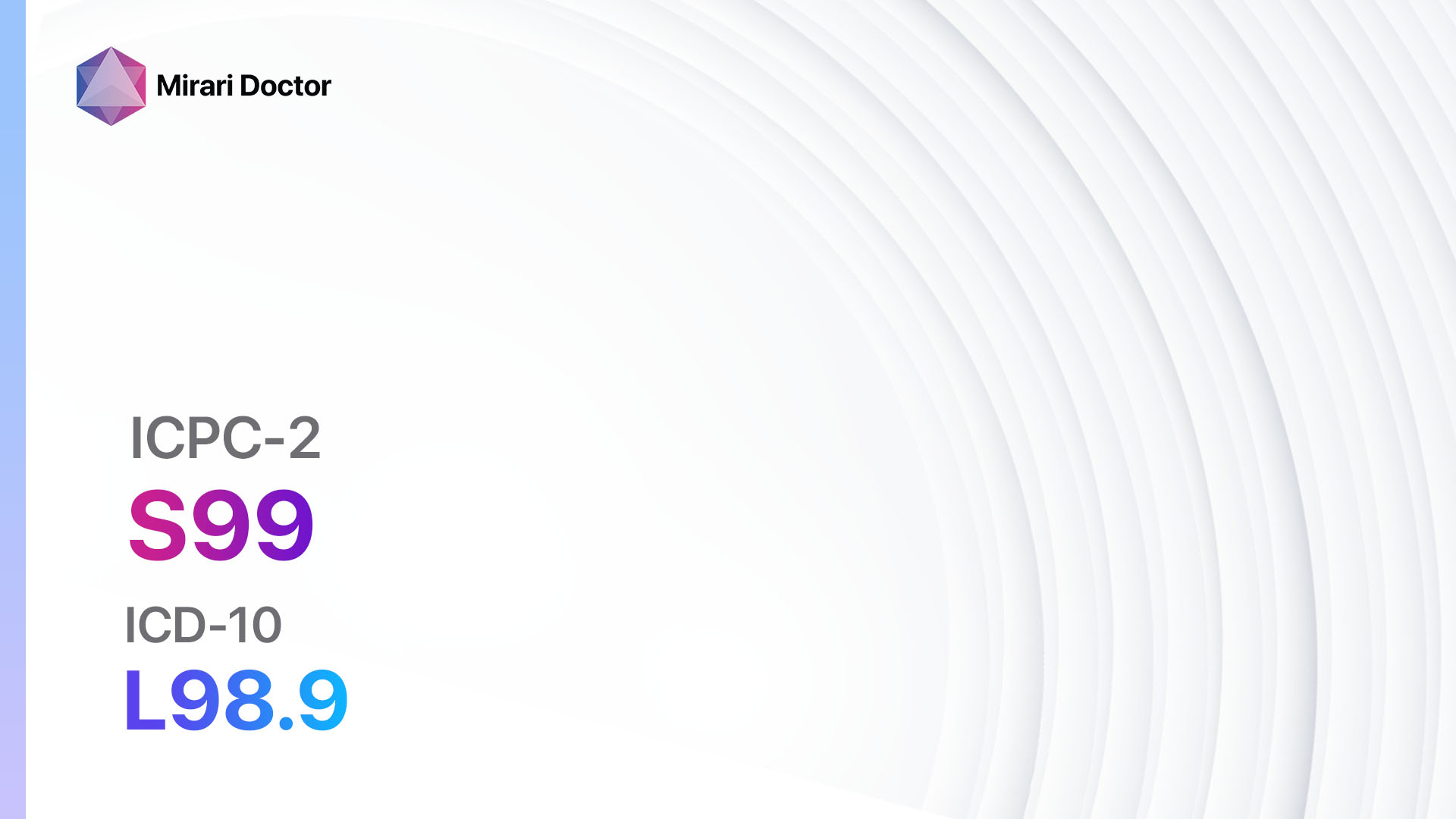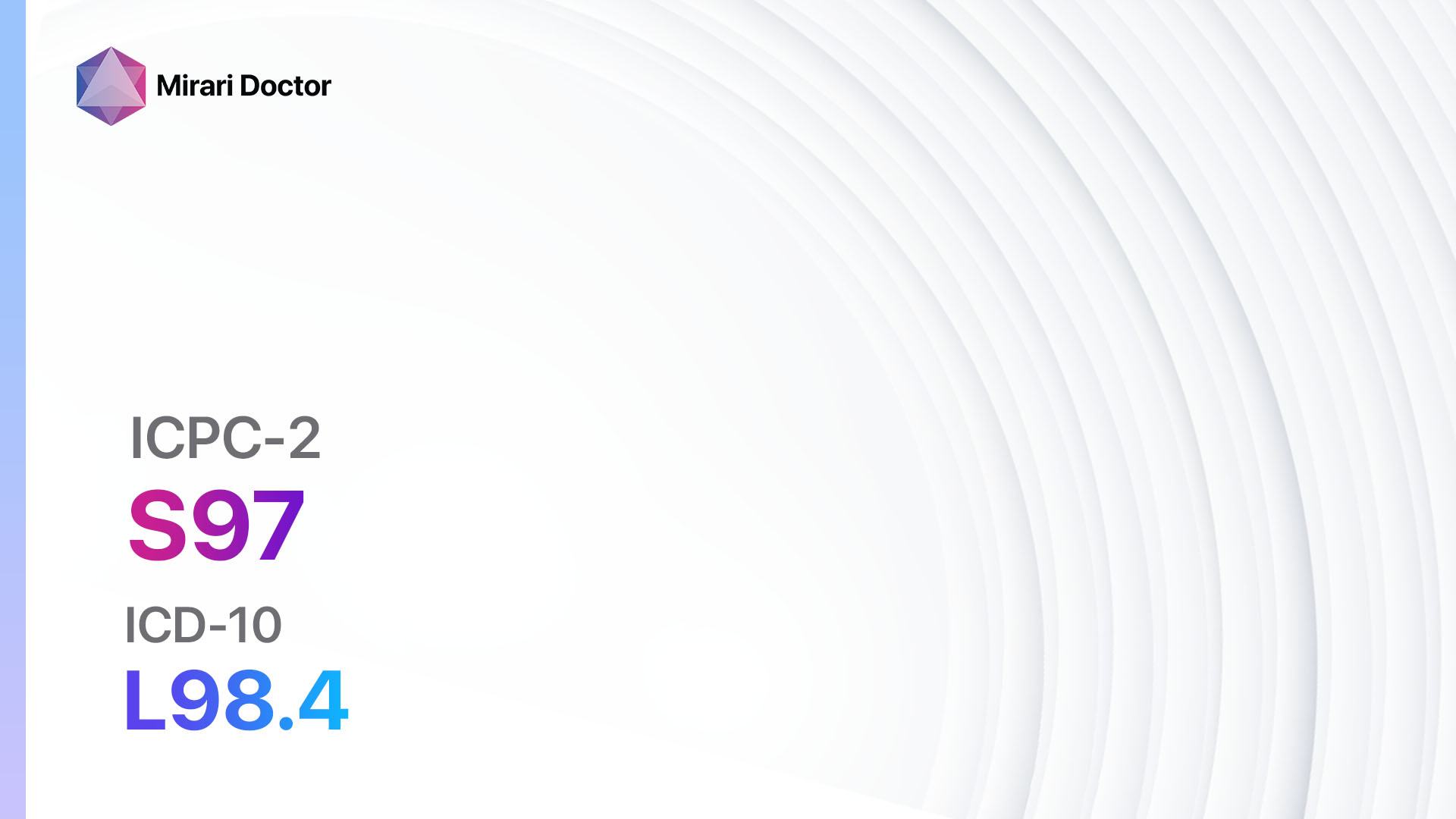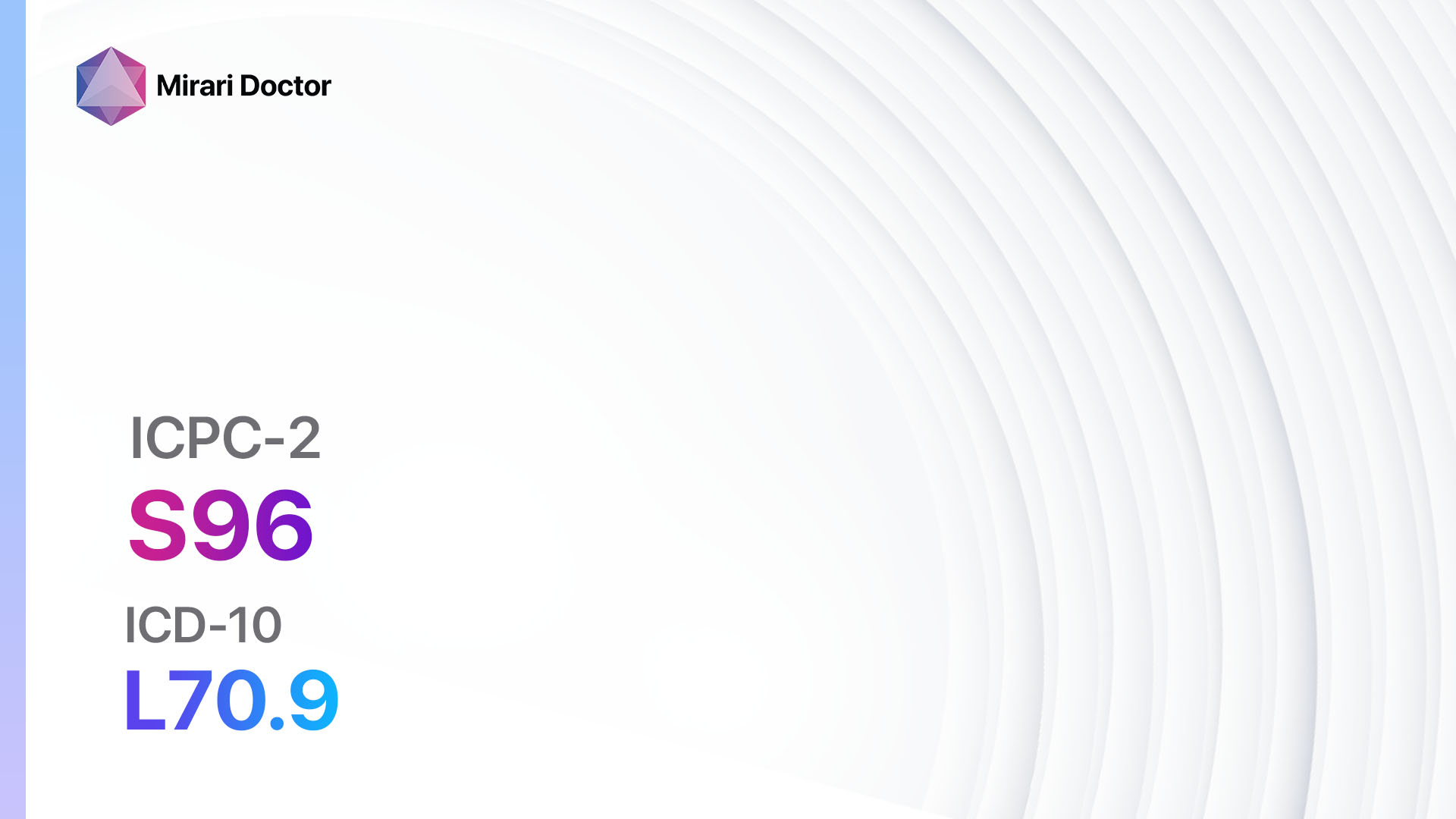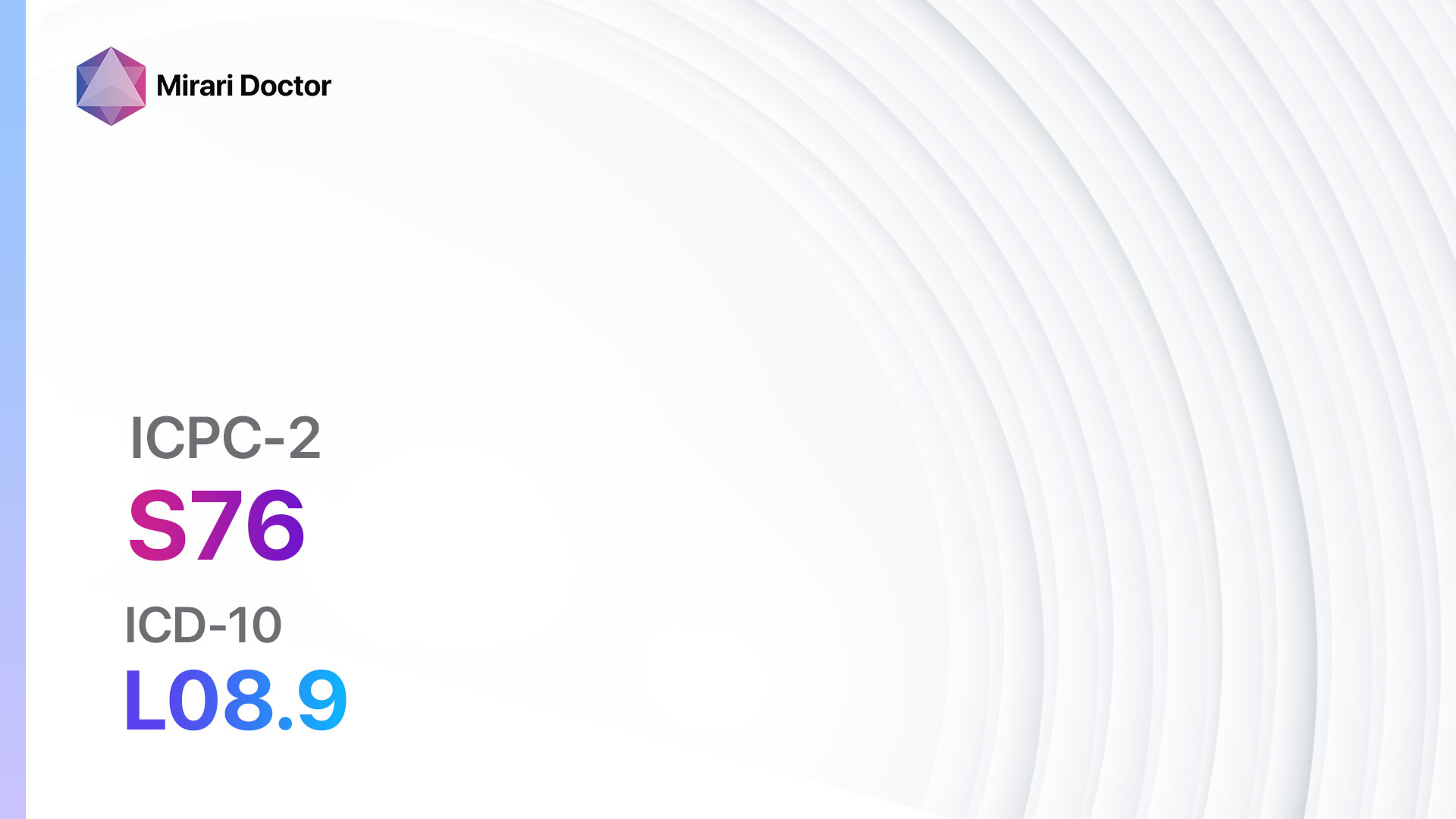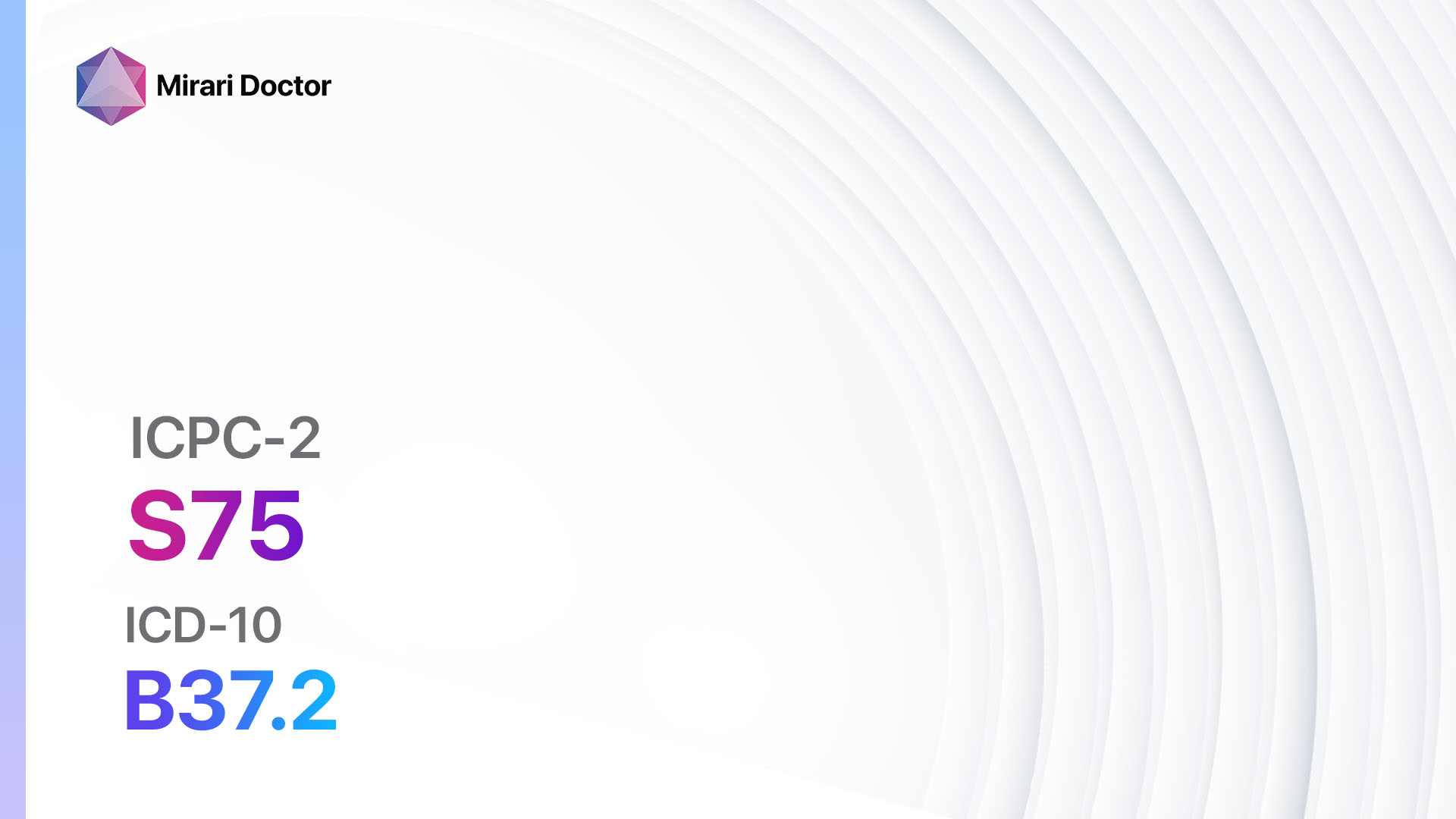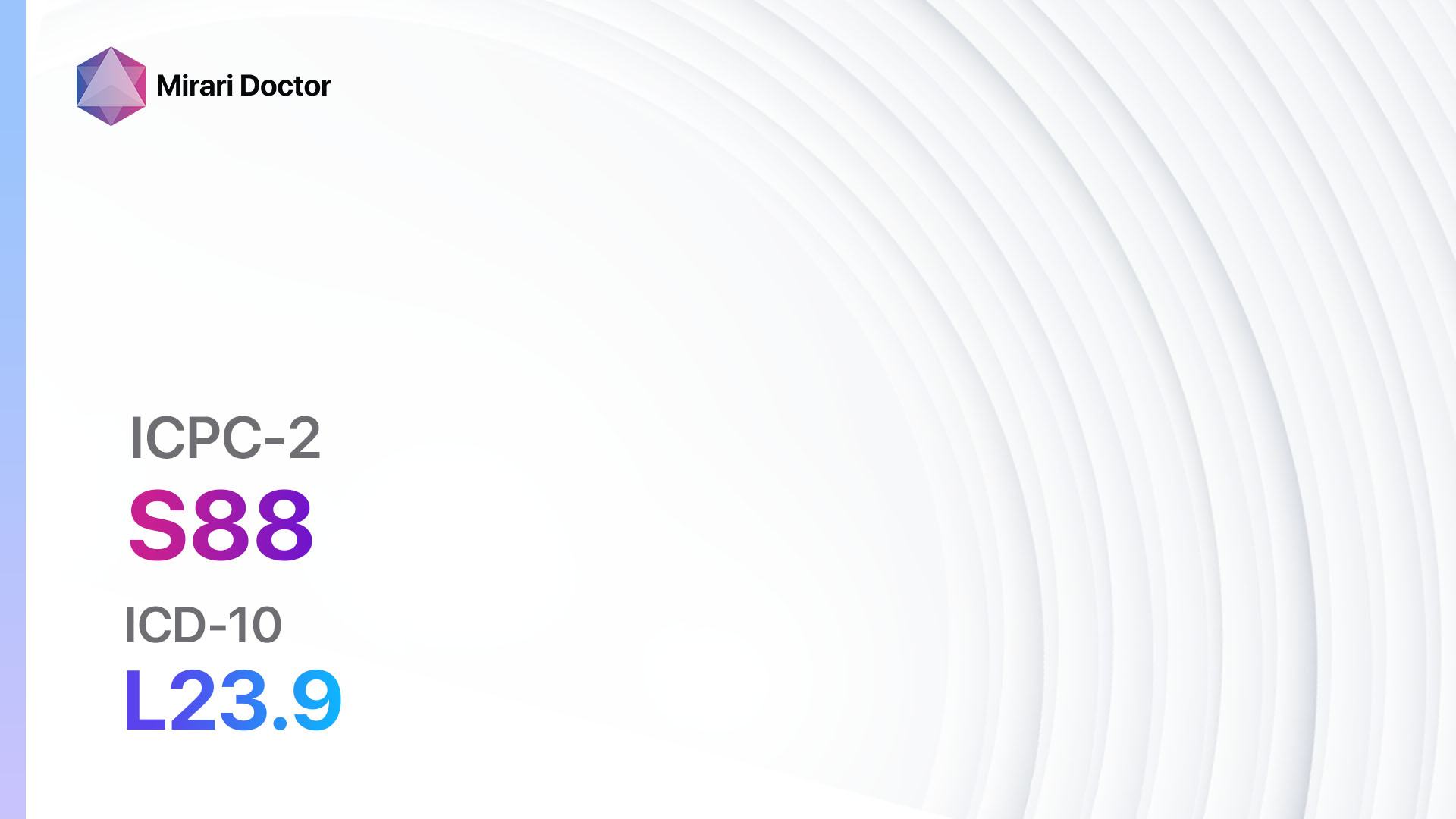
Introduction
Dermatitis contact/allergic is a common skin condition characterized by inflammation of the skin due to exposure to certain substances. It can cause itching, redness, and swelling, and can be triggered by various irritants or allergens[1]. The aim of this guide is to provide a comprehensive overview of the diagnostic steps and possible interventions for dermatitis contact/allergic.
Codes
- ICPC-2 Code: S88 Dermatitis contact/allergic
- ICD-10 Code: L23.9 Allergic contact dermatitis, unspecified cause
Symptoms
- Itching: Patients may experience intense itching in the affected area[2].
- Redness: The skin may appear red and inflamed[3].
- Swelling: Swelling of the skin may occur, especially in severe cases[4].
- Blisters: In some cases, small blisters may develop[5].
- Dry, cracked skin: The affected area may become dry and cracked[6].
- Pain or burning sensation: Some patients may experience pain or a burning sensation in the affected area[7].
Causes
- Allergens: Common allergens that can trigger allergic contact dermatitis include certain metals (e.g., nickel), fragrances, preservatives, and latex[8].
- Irritants: Irritant contact dermatitis can be caused by exposure to substances such as soaps, detergents, solvents, and chemicals[9].
Diagnostic Steps
Medical History
- Gather information about the patient’s occupation, hobbies, and exposure to potential allergens or irritants[10].
- Ask about the duration and pattern of
- Determine if there is a family history of dermatitis or other allergic
- Assess the patient’s overall health and any underlying medical conditions that may contribute to the development of dermatitis.
Physical Examination
- Inspect the affected area for signs of redness, swelling, blisters, or dry, cracked
- Look for any patterns or distribution of the rash that may indicate the cause of the
- Examine other areas of the body to check for involvement of multiple
Determine Severity
- Mild: Mild dermatitis is characterized by localized redness, itching, and minimal swelling. There may be no or minimal impact on daily activities.
- Moderate: Moderate dermatitis involves more widespread redness, swelling, and itching. It may cause discomfort and affect daily
- Severe: Severe dermatitis is characterized by intense redness, swelling, and Blisters may be present, and the condition can significantly impact daily activities.
Laboratory Tests
- Patch testing: Patch testing involves applying small amounts of potential allergens to the skin to identify specific triggers for allergic contact dermatitis.
- Blood tests: Blood tests may be done to check for elevated levels of specific antibodies or to rule out other underlying medical conditions.
Diagnostic Imaging
- No diagnostic imaging is typically necessary for the diagnosis of dermatitis contact/allergic.
Other Tests
- Skin biopsy: In some cases, a small sample of skin may be taken for examination under a microscope to confirm the diagnosis and rule out other skin conditions.
Follow-up and Patient Education
- Schedule follow-up appointments to monitor the progress of the dermatitis and adjust treatment as needed.
- Provide education on proper skin care, including avoiding triggers, using gentle cleansers, and moisturizing regularly.
- Discuss strategies to prevent future flare-ups, such as wearing protective clothing and gloves, and using barrier creams.
Possible Interventions
Traditional Interventions
Medications:
Top 5 drugs for Dermatitis contact/allergic:
- Topical corticosteroids (e.g., hydrocortisone, betamethasone):
- Cost: Generic versions can range from $5 to $30 per
- Contraindications: Hypersensitivity to corticosteroids, skin
- Side effects: Thinning of the skin, skin discoloration, burning or stinging
- Severe side effects: Adrenal suppression, allergic
- Drug interactions: None
- Warning: Prolonged use of high-potency corticosteroids may lead to systemic side
- Topical calcineurin inhibitors (e.g., tacrolimus, pimecrolimus):
- Cost: Generic versions can range from $50 to $200 per
- Contraindications: Hypersensitivity to calcineurin inhibitors, skin
- Side effects: Burning or stinging sensation, itching,
- Severe side effects: None
- Drug interactions: None
- Warning: Long-term safety of calcineurin inhibitors is still being
- Antihistamines (e.g., cetirizine, loratadine):
- Cost: Generic versions can range from $5 to $20 per
- Contraindications: Hypersensitivity to antihistamines, narrow-angle
- Side effects: Drowsiness, dry mouth,
- Severe side effects: None
- Drug interactions: Sedatives,
- Warning: Some antihistamines may cause drowsiness, so caution should be exercised when driving or operating machinery.
- Topical antibiotics (e.g., mupirocin, neomycin):
- Cost: Generic versions can range from $5 to $20 per
- Contraindications: Hypersensitivity to antibiotics, skin
- Side effects: Skin irritation, itching,
- Severe side effects: Allergic
- Drug interactions: None
- Warning: Topical antibiotics should not be used for extended periods to avoid the development of antibiotic resistance.
- Oral corticosteroids (e.g., prednisone, methylprednisolone):
- Cost: Generic versions can range from $5 to $30 per
- Contraindications: Hypersensitivity to corticosteroids, systemic fungal
- Side effects: Increased appetite, weight gain, mood
- Severe side effects: Adrenal suppression, osteoporosis, increased risk of
- Drug interactions: Nonsteroidal anti-inflammatory drugs (NSAIDs),
- Warning: Oral corticosteroids should be used with caution and for short durations due to the risk of systemic side effects.
Alternative Drugs:
- Topical immunomodulators (e.g., crisaborole, pimecrolimus): These drugs modulate the immune response and can be used as an alternative to corticosteroids.
- Systemic immunosuppressants (e.g., methotrexate, cyclosporine): These medications may be considered for severe cases of dermatitis that do not respond to other
- Antibacterial or antifungal agents: If a secondary bacterial or fungal infection is present, appropriate antimicrobial therapy may be necessary.
Surgical Procedures:
- Surgical procedures are not typically indicated for the treatment of dermatitis contact/allergic.
Alternative Interventions
- Moisturizers: Regular use of moisturizers can help hydrate the skin and reduce dryness and itching. Cost: $5-$20 per bottle.
- Wet dressings: Applying wet dressings to the affected area can help soothe the skin and reduce inflammation. Cost: Minimal.
- Avoidance of triggers: Identifying and avoiding triggers, such as specific allergens or irritants, can help prevent flare-ups. Cost: Varies.
- Stress management: Stress can exacerbate dermatitis symptoms, so stress management techniques, such as meditation or yoga, may be beneficial. Cost: Varies.
- Probiotics: Some studies suggest that probiotics may help improve symptoms of dermatitis. Cost: Varies depending on the specific product.
Lifestyle Interventions
- Avoid hot showers: Hot water can strip the skin of its natural oils, leading to dryness and irritation. Cost: Free.
- Use gentle cleansers: Harsh soaps and cleansers can further irritate the skin, so using gentle, fragrance-free cleansers is recommended. Cost: $5-$15 per bottle.
- Wear protective clothing: Wearing protective clothing, such as gloves or long sleeves, can help minimize contact with potential irritants or allergens. Cost: Varies.
- Use sunscreen: Sun exposure can worsen dermatitis symptoms, so using sunscreen with a high SPF is important. Cost: $10-$30 per bottle.
- Avoid scratching: Scratching can further damage the skin and worsen symptoms, so finding alternative ways to relieve itching, such as applying cold compresses, is recommended. Cost:
It is important to note that the cost ranges provided are approximate and may vary depending on the location and availability of the interventions.
Mirari Cold Plasma Alternative Intervention
Understanding Mirari Cold Plasma
- Safe and Non-Invasive Treatment: Mirari Cold Plasma is a safe and non-invasive treatment option for various skin conditions. It does not require incisions, minimizing the risk of scarring, bleeding, or tissue damage.
- Efficient Extraction of Foreign Bodies: Mirari Cold Plasma facilitates the removal of foreign bodies from the skin by degrading and dissociating organic matter, allowing easier access and extraction.
- Pain Reduction and Comfort: Mirari Cold Plasma has a local analgesic effect, providing pain relief during the treatment, making it more comfortable for the patient.
- Reduced Risk of Infection: Mirari Cold Plasma has antimicrobial properties, effectively killing bacteria and reducing the risk of infection.
- Accelerated Healing and Minimal Scarring: Mirari Cold Plasma stimulates wound healing and tissue regeneration, reducing healing time and minimizing the formation of scars.
Mirari Cold Plasma Prescription
Video instructions for using Mirari Cold Plasma Device – S88 Dermatitis contact/allergic (ICD-10:L23.9)
| Mild | Moderate | Severe |
| Mode setting: 1 (Infection) Location: 0 (Localized) Morning: 15 minutes, Evening: 15 minutes |
Mode setting: 1 (Infection) Location: 0 (Localized) Morning: 30 minutes, Lunch: 30 minutes, Evening: 30 minutes |
Mode setting: 1 (Infection) Location: 0 (Localized) Morning: 30 minutes, Lunch: 30 minutes, Evening: 30 minutes |
| Mode setting: 2 (Wound Healing) Location: 0 (Localized) Morning: 15 minutes, Evening: 15 minutes |
Mode setting: 2 (Wound Healing) Location: 0 (Localized) Morning: 30 minutes, Lunch: 30 minutes, Evening: 30 minutes |
Mode setting: 2 (Wound Healing) Location: 0 (Localized) Morning: 30 minutes, Lunch: 30 minutes, Evening: 30 minutes |
| Mode setting: 3 (Antiviral Therapy) Location: 0 (Localized) Morning: 15 minutes, Evening: 15 minutes |
Mode setting: 3 (Antiviral Therapy) Location: 0 (Localized) Morning: 30 minutes, Lunch: 30 minutes, Evening: 30 minutes |
Mode setting: 3 (Antiviral Therapy) Location: 0 (Localized) Morning: 30 minutes, Lunch: 30 minutes, Evening: 30 minutes |
| Mode setting: 10 (Dermatitis/Fungus) Location: 0 (Localized) Morning: 15 minutes, Evening: 15 minutes |
Mode setting: 10 (Dermatitis/Fungus) Location: 0 (Localized) Morning: 30 minutes, Lunch: 30 minutes, Evening: 30 minutes |
Mode setting: 10 (Dermatitis/Fungus) Location: 0 (Localized) Morning: 30 minutes, Lunch: 30 minutes, Evening: 30 minutes |
| Total Morning: 60 minutes approx. $10 USD, Evening: 60 minutes approx. $10 USD |
Total Morning: 120 minutes approx. $20 USD, Lunch: 120 minutes approx. $20 USD, Evening: 120 minutes approx. $20 USD, |
Total Morning: 120 minutes approx. $20 USD, Lunch: 120 minutes approx. $20 USD, Evening: 120 minutes approx. $20 USD, |
| Usual treatment for 7-60 days approx. $140 USD – $1200 USD | Usual treatment for 6-8 weeks approx. $2,520 USD – $3,360 USD |
Usual treatment for 3-6 months approx. $5,400 USD – $10,800 USD
|
 |
|
Use the Mirari Cold Plasma device to treat Dermatitis contact/allergic effectively.
WARNING: MIRARI COLD PLASMA IS DESIGNED FOR THE HUMAN BODY WITHOUT ANY ARTIFICIAL OR THIRD PARTY PRODUCTS. USE OF OTHER PRODUCTS IN COMBINATION WITH MIRARI COLD PLASMA MAY CAUSE UNPREDICTABLE EFFECTS, HARM OR INJURY. PLEASE CONSULT A MEDICAL PROFESSIONAL BEFORE COMBINING ANY OTHER PRODUCTS WITH USE OF MIRARI.
Step 1: Cleanse the Skin
- Start by cleaning the affected area of the skin with a gentle cleanser or mild soap and Gently pat the area dry with a clean towel.
Step 2: Prepare the Mirari Cold Plasma device
- Ensure that the Mirari Cold Plasma device is fully charged or has fresh batteries as per the manufacturer’s instructions. Make sure the device is clean and in good working condition.
- Switch on the Mirari device using the power button or by following the specific instructions provided with the device.
- Some Mirari devices may have adjustable settings for intensity or treatment Follow the manufacturer’s instructions to select the appropriate settings based on your needs and the recommended guidelines.
Step 3: Apply the Device
- Place the Mirari device in direct contact with the affected area of the Gently glide or hold the device over the skin surface, ensuring even coverage of the area experiencing.
- Slowly move the Mirari device in a circular motion or follow a specific pattern as indicated in the user manual. This helps ensure thorough treatment coverage.
Step 4: Monitor and Assess:
- Keep track of your progress and evaluate the effectiveness of the Mirari device in managing your Dermatitis contact/allergic. If you have any concerns or notice any adverse reactions, consult with your health care professional.
Note
This guide is for informational purposes only and should not replace the advice of a medical professional. Always consult with your healthcare provider or a qualified medical professional for personal advice, diagnosis, or treatment. Do not solely rely on the information presented here for decisions about your health. Use of this information is at your own risk. The authors of this guide, nor any associated entities or platforms, are not responsible for any potential adverse effects or outcomes based on the content.
Mirari Cold Plasma System Disclaimer
- Purpose: The Mirari Cold Plasma System is a Class 2 medical device designed for use by trained healthcare It is registered for use in Thailand and Vietnam. It is not intended for use outside of these locations.
- Informational Use: The content and information provided with the device are for educational and informational purposes They are not a substitute for professional medical advice or care.
- Variable Outcomes: While the device is approved for specific uses, individual outcomes can differ. We do not assert or guarantee specific medical outcomes.
- Consultation: Prior to utilizing the device or making decisions based on its content, it is essential to consult with a Certified Mirari Tele-Therapist and your medical healthcare provider regarding specific protocols.
- Liability: By using this device, users are acknowledging and accepting all potential Neither the manufacturer nor the distributor will be held accountable for any adverse reactions, injuries, or damages stemming from its use.
- Geographical Availability: This device has received approval for designated purposes by the Thai and Vietnam FDA. As of now, outside of Thailand and Vietnam, the Mirari Cold Plasma System is not available for purchase or use.
References
- Cleveland Clinic. Contact Dermatitis. https://my.clevelandclinic.org/health/diseases/6173-contact-dermatitis
- American College of Allergy, Asthma & Immunology. Contact Dermatitis. https://acaai.org/allergies/allergic-conditions/skin-allergy/contact-dermatitis/
- Healthline. Contact Dermatitis. https://www.healthline.com/health/contact-dermatitis
- Yale Medicine. Allergic Contact Dermatitis. https://www.yalemedicine.org/conditions/dermatitis
- InformedHealth.org. Overview: Allergic contact dermatitis. https://www.ncbi.nlm.nih.gov/books/NBK447113/
- NHS. Contact dermatitis. https://www.nhs.uk/conditions/contact-dermatitis/
- Johns Hopkins Medicine. Contact Dermatitis. https://www.hopkinsmedicine.org/health/conditions-and-diseases/contact-dermatitis
- Medscape. Allergic Contact Dermatitis. https://emedicine.medscape.com/article/1049216-overview
- Mayo Clinic. Contact dermatitis. https://www.mayoclinic.org/diseases-conditions/contact-dermatitis/symptoms-causes/syc-20352742
- American Family Physician. Diagnosis and Management of Contact Dermatitis. https://www.aafp.org/pubs/afp/issues/2010/0801/p249.html
Related articles
Made in USA



